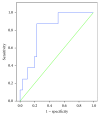Serum Adiponectin Level as a Predictor of Subclinical Cushing's Syndrome in Patients with Adrenal Incidentaloma
- PMID: 27656211
- PMCID: PMC5021502
- DOI: 10.1155/2016/8519362
Serum Adiponectin Level as a Predictor of Subclinical Cushing's Syndrome in Patients with Adrenal Incidentaloma
Abstract
Subclinical Cushing's syndrome (SCS) is a condition of slight but chronic cortisol excess in patients with adrenal incidentaloma (AI) without typical signs and symptoms of Cushing's syndrome. Adiponectin has potent roles in modulating energy balance and metabolic homeostasis and acts in opposition to glucocorticoids. This study aimed to evaluate adiponectin level in SCS and nonfunctional AI (NAI) patients and its relation with metabolic parameters. Patients with AI (n = 40) and metabolically healthy controls (n = 30) were included. In AI patients and controls, detailed medical history assessment, physical examinations, anthropometric measurements, and laboratory measurements were performed. Age, body mass index, waist circumference, and lipid profiles were significantly higher and waist-to-hip ratio and adiponectin level were significantly lower in the AI patients than in the controls. The midnight cortisol and urinary free cortisol levels were significantly higher in the SCS patients (n = 8) than in the NAI patients (n = 32). Adiponectin level of the SCS group was significantly lower than those of the NAI and control groups. The sensitivity and specificity for an adiponectin level of ≤13.00 ng/mL in predicting the presence of SCS were 87.5% and 77.4%, respectively. In conclusion, adiponectin is valuable in predicting the presence of SCS in AI patients.
Figures



References
LinkOut - more resources
Full Text Sources
Other Literature Sources

